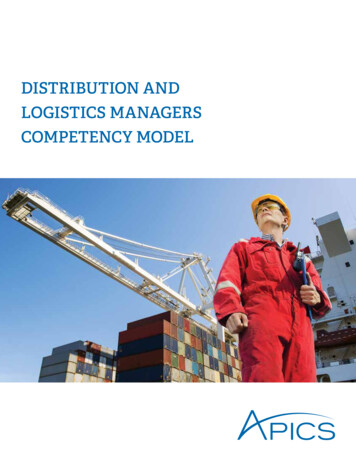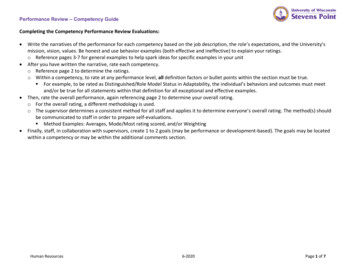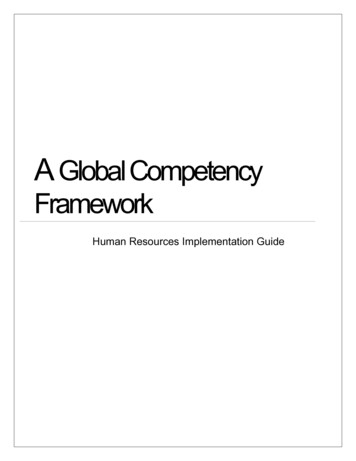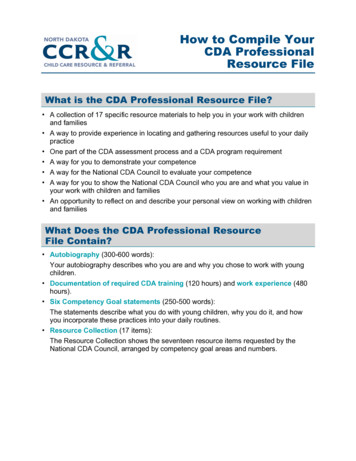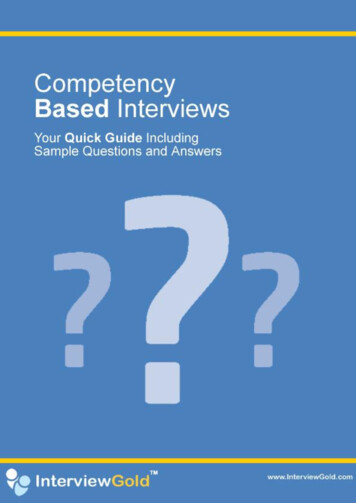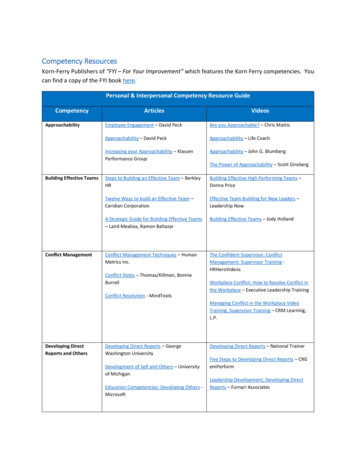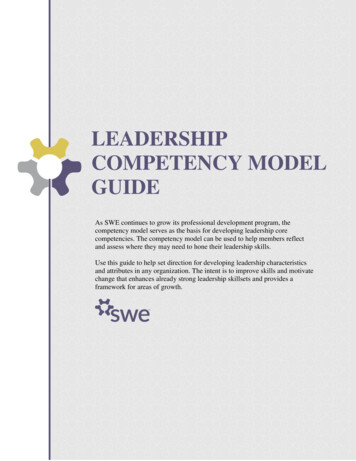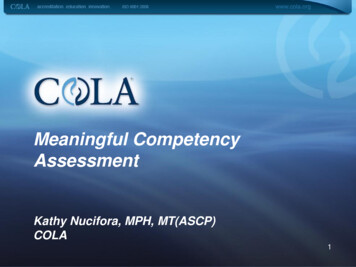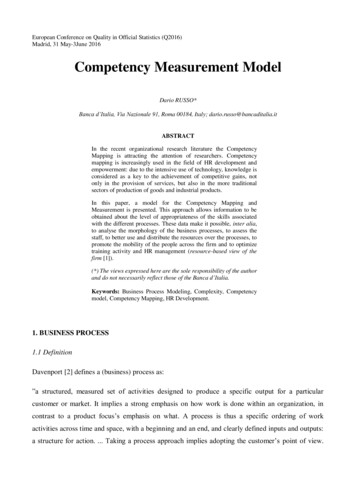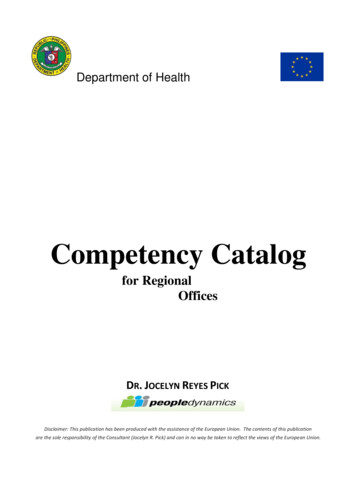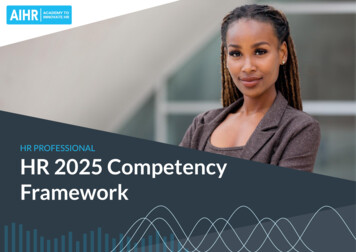
Transcription
HR PROFESSIONALHR 2025 CompetencyFramework
Professional HRCompetency FrameworkStrategic & T-shaped HR ProfessionalsCore HR CompetenciesThe AIHR Competency Framework identifies what it takes to be amodern and relevant HR Professional who drives business valueIt is no longer enough to specialize in one single functional HRcompetency. HR Professionals need to become a generalist in fourcore HR competencies and a specialist in at least one functionalcompetency.The AIHR framework is used globally to cater to the need formore strategic, T-Shaped HR Professionals.Functional HR Competenciesacross the full HR spectrum.
T-Shaped HR ProfessionalsData LiteracyBusiness AcumenDigital IntegrationPeople AdvocacyThe ability to read, apply, create,and communicate data intovaluable information in order toinfluence decision-makingprocesses.The ability to translate theorganization’s purpose, mission,goals, and context into strategy,positioning HR policies andactivities to best serve theorganization’s interests.The ability to leverage technologyto increase efficiency and to driveHR and business value.The ability to create a stronginternal culture, get the best out ofpeople, and acts as a trustedchampion and communicationsexpert.Page 5Page 9Page 14Page 19FunctionalCompetenciesHR Professionals need to becomea specialist in at least onefunctional competency and ageneralist in four core HRcompetencies.
Professional HRCompetency FrameworkWhat is a competency framework?How are competencies structured?A competency is a cluster of skills, knowledge, and expertiseIn this framework, a competency is split up into multipleneeded to become efficient at performing a specific job.dimensions. Each construct consists out of different behavioralThe aggregate of competencies that are important to a particularrole or (HR) function is what we call a competency model.A competency model provides a tangible framework forperformance management, skill gap analysis, upskilling, andprovides a template for what the ideal (HR) organization will looklike.abilities.For example, data literacy is divided into two dimensions: datadriven and analytics translator. Each of these dimensions hasbehaviors related to them. For data driven, these include theability to read data, apply data, and communicate data.Each behavior is scored on three proficiency levels, making it easyto assess the proficiency of individuals or groups.
CORE HR COMPETENCY #1Data Literacy
Data LiteracyDefinitionData literacy is the ability to read, apply, create, and communicate data into valuable information to influence decision-making processes.DescriptionData has never been more important in how we do business.Besides understanding internal data sources, the HR professionalDepartments like finance, marketing, and sales live and breathe data.should also be able to leverage the insights from data from outside ofTheir strategic impact is often directly related to their performancethe organization by staying informed with the latest research. Thesenumbers, and effective management of these departments relies onevidence-based practices will help HR focus on issues that will createtracking budget and actuals, sales results, return on investment, andtangible value for the organization.return on ad spend. Compared to these disciplines, HR is still catchingup.A proficient performerA data literate HR professional:In an HR context, data includes the use of metrics, KPIs, scorecards, and Sets effective HR KPIsdashboards to make informed decisions. This requires the HR Reads and interprets HR and business dataprofessional to read data and understand how different data points Leverages data to make better decisionscontribute to strategic HR and business goals. This is referred to as data Spots opportunities for value-adding data analysisdriven. This does not mean that all HR professionals need to become Effectively communicates datadata analysts. Practices evidence-based HRRather, they need to be able to work with data specialists, assess theirfindings and results, and effectively translate these insights into actionsthat create business value. This is what we define as the analyticstranslator.
Data LiteracyData DrivenData Driven - Professional PerformanceBehaviorsElementary performance (beginner) Intermediate performance (intermediate) Proficient performance (advanced)1Occasionally uses data in a mostlyad-hoc fashion by using scorecardsand accessing dashboards.Reading dataRegularly leverages descriptive dataanalysis· To set targets· To answer questionsFrequently leverages descriptive data analysis· To set targets· To answer questions· To guide daily operations· To provide contextRegularly leverages scorecards· To measure HR efficiencies· To measure HR outcomesFrequently leverages scorecards· To measure HR efficiencies· To measure HR outcomes· To measure the impact of HR on the business2Applying dataStruggles to make sense of dataTurns data into information on a regularbasis within their own specializationTurns data into value-adding information through diagnostic analysisbased on various available data (reports, scorecards, and dynamicdashboards)3Creating dataDoes generally not set KPIs tomeasure and increase both personaland stakeholder effectiveness.Regularly establishes both personal andwith stakeholders KPIs· To set targets· To measure effectiveness· To measure goal attainmentWhenever it adds value, creates KPI-driven activities, projects, andstrategies that seamlessly connect with business priorities· Develops and interpret strategic plans· Connect them to KPIs· Identify current scores· Set target scores4Communicating dataIs unable to show stakeholders howHR contributes to business strategyusing dataIs able to show stakeholders how HRShows stakeholders how HR contributes to business strategy andcontributes to business strategy using data results through data-fueled cause-and-effect relationships5Practicing evidence-based Questions unproven assumptions.HRValidates assumptions using data.Validates assumptions using data and stays informed on the latestscientific research and uses it in daily tasks and operation
Data LiteracyAnalytics TranslationAnalytics Translation - Professional PerformanceBehaviorsElementary performance (beginner)Intermediate performance (intermediate)Proficient performance (advanced)1Bridging analyticsStruggles to explain the relationshipbetween business and HR using peopleinsightsCreates some impact by connecting peopleanalytics insights to operational expertise ofbusiness and HR stakeholdersPlays a critical role in connecting people analytics insights to theoperational expertise of business and HR stakeholders bytranslating them to impact at scale2Driving adoptionStruggles to accurately explain whatpeople analytics is and rarely createsimpact by leveraging data; does notdrive adoptionUnderstands people analytics and the value of Drives the adoption of people analytics and the use of data in bothusing data, and occasionally leverages this toHR and the business through a deep understanding and by involvingcreate more impactand explaining it to peers and business stakeholders3Leveraging dataStruggles to effectively read, apply, and Has average data literacy and derivescommunicate data as information indata-driven insights within their HRmost HR contexts.specializationActively identifies how data analysis can be leveraged to makebetter decisions in their daily workCreates constant value by reading, applying, and communicatingdata as information in order to influence decision-making processesin HR and the business4IdentifyingopportunitiesStruggles to identify HR issues in which Occasionally shares HR issues that can befurther data analysis can add valuesolved with data to the people analytics teamor other specialistsActively raises relevant HR and business issues that can be solvedwith data to the people analytics team or other specialists5PrioritizationUnable to effectively separate coreissues from side issuesIs able to separate core issues from side issues Instinctively identifies core issues and separate them from sidewhen asked to do soissues6Evidence-basedpracticesOccasionally seeks out new knowledgeof the latest HR and managementresearch and best practicesActively acquires new knowledge of the latest Maintains up-to-date knowledge of the latest HR and managementHR and management research and bestresearch and best practices and actively applies it in their daily workpracticesto create value for stakeholders and the end-customer
CORE HR COMPETENCY #2Business Acumen
Business AcumenDefinitionBusiness acumen, also known as business savvy or business sense, is the ability to translate the organization’s purpose, mission, goals, and business contextinto strategy, positioning HR policies and activities to best serve the organization’s interests.DescriptionBusiness acumen is the HR competency that has received the mostMoreover, they need to develop a customer orientation, meaning theyattention in the past three decades. Since the introduction of theunderstand the organization’s end-customers and align HR policies with thesebusiness partner role, HR professionals have had to upskill in businesscustomers.acumen, and despite tremendous improvements there is still a long wayto go. HR needs to shift its focus from the more mundane andoperational HR issues towards the big picture. After all, businessesdon’t exist to make managers and employees happy; they exist to makecustomers and other stakeholders happy.To achieve this, HR professionals need to develop a solid understandingof the business, its customers, shareholders, and other stakeholders.This will help them to better understand the problems that linemanagers and executives are trying to solve, and it will help HR positiontheir business to win in its marketplace.To build business acumen, the HR professional first needs to understandthe global context of work, and the internal organizational dynamics, apractice we call context interpretation.Only when this is the case will the HR professional be able to participate instrategic co-creation, practicing strategic human resource management, andco-creating business strategy.A proficient performerAn HR professional with business acumen: Builds competitive advantages through their understanding of theorganization, the industry, and its competitive landscape Designs HR practices that serve end-customers and other stakeholders Aligns HR activities with business priorities Balances competing interests to drive organizational effectiveness Provides a significant strategic contribution to the business
Business AcumenContext InterpretationContext Interpretation - Professional PerformanceBehaviorsElementary performance (beginner)Intermediate performance (intermediate)Proficient performance (advanced)1EnvironmentalawarenessHas limited understanding of the externalenvironment in which the organizationoperates; does not weigh these factorsinto decision-makingHas intermediate understanding of the social,cultural, technological, political, economic, andlegal context in which the organization operatesand lets these factors influence their (HR)decision-makingHas deep understanding of the social, cultural, technological,political, economic, and legal context in which the organizationoperates and includes these factors in their decision-making2Mobilizingagainst threatsRarely spots external threats andOccasionally spots external threats anddevelopments that may impact HR policies developments that may impact HR policies andtakes action on them3OrganizationalunderstandingLimited understanding of theorganization’s primary processes and itsplace in the industry value chainActively spots external threats that inhibit the company fromreaching its goals and takes action within the HR domain to limittheir impactIs able to explain the organization’s primaryCan effortlessly explain the organization’s primary processprocesses, its place in the industry value chain andCan effortlessly explain the position of the organization in thehow it adds value to customerswhole industry value chain; knows the roles of its partners (e.g.,suppliers, vendors, distributors) and what differentiates themContinuously looks to identify sources of competitiveadvantage within their specialization and promotes themthrough their business partnering activities4IndustryunderstandingHas limited understanding of how theorganization differentiates itself from itscompetitionHas an intermediate understanding ofmanagement theories (i.e., resource-based view,transaction cost economics)Is able to apply common management theories to examine theorganization and organization challenges (i.e., resource-basedview, transaction cost economic, resource dependency theory,strategic management theory, organizational learning,institutional theory)Has an intermediate understanding of thedifferent ways of how the organizationdifferentiates itself from its competition andknows how HR contributes to this differentiationHas deep understanding of how the organization differentiatesitself from its competition, knows how HR contributes to thisdifferentiation and actively leverages this understanding tomake HR policies more effective
Business AcumenCustomer OrientationCustomer Orientation - Professional PerformanceBehaviorsElementary performance (beginner)Intermediate performance (intermediate)Proficient performance (advanced)1Has limited understanding of theend-customerIntermediate understanding of theend-customer’s needs and responsibilities andthe ways the organization adds value to thecustomerDeeply understands the end-customer’s needs and responsibilitiesand is able to explain the different ways the organization addsvalue to the customerPositions HR activities to better serve theend-customerAligns HR activities, policies, and strategies to (help the business)serve the end-customer in better waysExternal customeralignment2Internal customeralignmentHas limited capacity to effectivelymarket HR internally and externallyIs able to effectively market HR to both internal Speaks the language of the business and effectively markets HR toand external stakeholdersboth internal stakeholders (e.g., through HR costing and ROI) andexternal stakeholders (e.g., through communities, employerbranding, employee value propositions)3GatheringinformationHas limited connection to internalcustomers; only deals with people whoare important in execution of theirtasksGoes beyond direct internal customers anddirect stakeholders; makes active effort tounderstand whole internal stakeholderecosystemContinuously searches for relevant connections in theorganizational ecosystem to better understand different internaland external stakeholders and, as a result, organizational needs4Customer-drivenpracticesLimited understanding of designthinking and their applicationHas intermediate understanding of designthinking and regularly applies its principles tooptimize processes and customer experienceHas deep understanding of design thinking and lean principles andapplies them when appropriate to optimize processes andcustomer experience
Business AcumenStrategic Co-creationStrategic Co-creation - Professional PerformanceBehaviorsElementary performance (beginner) Intermediate performance (intermediate)Proficient performance (advanced)1Strategic behaviorDisplays limited consideration forissues outside their immediateresponsibilityDisplays some strategic behaviors:· Anticipates threats and opportunities on theperiphery of the business· Challenges assumptions and encouragedivergent points of view· Interprets complex and conflictinginformationDisplays strong strategic behaviors:·Anticipates threats and opportunities on the periphery ofthe business·Challenges assumptions and encourage divergent points ofview·Interprets complex and conflicting information·Balances informed decision-making with swift action·Aligns by finding common ground and achieving buy-in·Continuously learns and searches for new information andtrends2StrategicunderstandingHas limited understanding of theorganizational strategy and goals.Has advanced understanding of theorganizational strategy and goals.Has deep understanding of the organizational strategy, includingorganizational goals and key sources of competitive advantage.3Strategic alignmentRarely spots HR opportunities thatcan help the business be morecompetitiveOccasionally spots HR opportunities that canActively spots HR opportunities that can help the business behelp the business be more competitive and takes more competitive and successfully leverages themaction to leverage them.Constantly looks for opportunities to integrate HR practices tocreate synergies towards key business goals4Strategic contribution Rarely contributes to strategydiscussion and decision-makingOccasionally contributes to strategy discussionand decision-makingContributes to strategy discussions and decision-makingAligns with stakeholders to create overview of interests andbusiness priorities and manages them to advance HR policiesthat help boost the business
CORE HR COMPETENCY #3Digital Integration
Digital IntegrationDefinitionDigital integration is the ability to leverage technology to increase efficiency and to drive HR and business value.DescriptionThough technology is everywhere in business, digital initiatives oftenThe modern HR professional is not only aware of the role of technologyoperate independently from each other in HR. In the future, digital toolsbut also practices technology embedding, meaning that they leveragewill be seamlessly integrated with the way we work to the degree that ittechnology to enable the HR and business strategy.will be nearly impossible to remember how anyone got anything done“the old way”.At the same time, digital solutions will be integrated horizontally,meaning that all HR data over the full employee journey is integratedwith each other, leading to a much better HR service delivery, highquality and actionable data, and tangible opportunities to better deliverthe HR strategy.Last, they are a digital culture builder: they build a technology-firstmindset that helps to optimize the employee experience, adds value tothe business, and enables technology adoption in the workforce.A proficient performerAn HR professional who is a digital integrator: Is technologically savvy Leverages technology to improve personal effectivenessDigital integration requires awareness of available technology both Leverages technology to improve HR service deliveryinside and outside of the organization, as well as the ability to integrate Leverages technology to improve organizational effectivenesstechnology to make HR more effective and drive business value. Digital Effectively implements new technology & builds a digital-first cultureintegration includes technological awareness first, which is theunderstanding of the digital landscape and its role in the world of work.
Digital IntegrationTechnological AwarenessTechnological Awareness - Professional PerformanceBehaviorsElementary performance (beginner)Intermediate performance (intermediate) Proficient performance (advanced)1Has limited understanding of technologicaltrends outside of the organizationHas an intermediate understanding oftechnological trends outside of theorganization and how they could impactthe business and HR policies.Has deep understanding of technological trends outside of theorganization and how they can potentially impact theorganization and HR policies; has the proficiency to explainthese to others in detailOccasionally reads, connect with peers,learns, or attends conferences with thespecific aim of staying up to date ontechnological developmentsStays up to date on technological innovation through a strongset of information collecting behaviors, including networking,learning, reading, and actively engaging vendorsStays informed with HR technology, isfamiliar with current HR systems, and isable to explain how technology mightimpact the future of work in theirorganization as well as how it will impacttheir area of expertise.Has deep understanding of the role of technology in the currentHR landscape:·Understands the HR technology vendor landscape for theirspecialization·Is informed on how other organizations leverage HRtechnology·Familiar with current HR systems·Has an informed opinion on the current state of HR tech inand outside of the organizationOccasionally identifies opportunities fortechnology to be leveraged within theorganizational contextSpots opportunities to leverage technology within theorganizational and HR contextHas an intermediate understanding ofdifferent technological tools and appliesthem in their daily workHas deep understanding of different technological tools andapplications; quickly learns how to use new gTechnology savvyHas limited understanding of how technologymight impact the future of work in theirorganization as well as how it will impact theirarea of expertiseHas limited understanding of the mostfrequently used software applications in theirdaily work
Digital IntegrationTechnological EmbeddingTechnological Embedding - Professional PerformanceBehaviorsElementary performance(beginner)Intermediate performance(intermediate)Proficient performance (advanced)1Strategic technologyHas limited understanding ofhow technology can drive HRefficienciesHas intermediate understanding of howtechnology can drive HR efficiencies andeffectivenessHad deep understanding of how technology enables & drives HR activities, HRstrategy, and business strategy and is actively involved in projects that drive HRefficiencies and effectiveness.2Technology roadmapHas limited understanding ofhow technological maturityand the current stage of theorganizationHas a general understanding of theUnderstands the organization’s digital HR maturity level:organization’s technological roadmap and· Identifies key components of digital maturitynext steps to create a more digital mature· Assesses maturity on all componentsorganization· Is involved in activities, projects, or roadmap drafting to increase maturity· Actively contributes to maturing the organization through their own role and HRspecialization3Customer-centricsolutionsApplies design thinkingtechniques to gatherinformation and interpretfindings to solve problemsApplies basic design thinking techniques Applies the design thinking process and techniques toto gather information and interpret· Gathering information from customers and users through discovery techniquesfindings to define, test, and iterate (digital)· Interpreting findings and defining user requirementssolution requirements· Spotting opportunities through ideation· Prototyping, testing, evaluating, and iterating digital solutions4Technology selectionHas limited understanding ofthe HR technology acquisitionprocess.Has an intermediate understanding of the Understands the HR technology acquisition cycle, including mission and visionHR technology acquisition processdevelopment, alignment on requirements, criteria selection, and criteria evaluation5TechnologycontributionHas limited understanding ofthe added value of new(software) solutions and theirimpact on strategic goalsUnderstands the added value of newdigital solutions and how they impact HRprocesses and strategic prioritiesTechnologyimplementationHas a limited understanding of Has an intermediate understanding ofHas a deep understanding of digital solution implementation processes and all actionsdigital solution implementation digital solution implementation processes, involved:processesincluding:· Plan and align· Planning· Define and design· Designing· Configure and test· Configuring· Train and communicate· Deploy and sustain6Actively searches for ways to improve HR processes using technologyIs able to effortlessly specify the added value of new digital solutions and their impacton HR and business goals
Digital IntegrationDigital Culture BuildingDigital Culture Building - Professional PerformanceBehaviorsElementary performance (beginner)Intermediate performance (intermediate)Proficient performance (advanced)1Digital fosteringHas limited digital capabilities.Is involved in upskilling initiatives and otherdigital capability building activities.Actively participates in building a more digital HR cultureby setting an example, coaching others, helping to unlearnbad habits, and contributing to digital initiatives.2Digital understandingHas limited understanding of how digitalcapabilities drive long-term valueUnderstands how digital capabilities drivelong-term sustainable valueHas deep understanding how digital capabilities drivelong-term, sustainable value for the organization and isable to effectively communicate this to key stakeholders3Digital value chainHas limited understanding of the changes thata digital integration brings to the operatingmodel and service deliveries, for both HR aswell as for the organizationHas intermediate understanding of the changes Has a deep understanding of the changes that a digitalthat digital integration brings to the operatingintegration brings to the operating model and servicemodel and service deliveries for both HR and the deliveries for both HR and the organizationorganization4Digital leadershipHas limited understanding of digitaldevelopments within their HR specializationHas intermediate understanding of digitaldevelopments within their HR specializationIs a digital leader in their HR specialization and how itconnects to other specialization; promotes digital valuesthrough their business partnering activities5Digital capability buildingContributes to workforce-wide digitalupskilling in limited capacityContributes to workforce-wide digital upskillingby setting an example, coaching stakeholders,encouraging leaders to set an example, helping tounlearn bad habits, and by contributing toorganization-wide digital initiativesActively contributes to workforce-wide digital upskillingby setting an example, coaching stakeholders, encouragingleaders to set an example, helping to unlearn bad habits,and by contributing to organization-wide digital initiativesin an impactful and strategic way.6Learning championHas limited involvement in building digitalcapabilities and stimulating innovation in theorganizationIs involved in improving digital learning andstimulating innovation in the organizationActively contributes to interventions that increaselearning and innovation:· Implements HR practices that support innovation· Implements HR practices that support learning andknowledge sharing
CORE HR COMPETENCY #4People Advocacy
People AdvocacyDefinitionPeople advocacy is about creating a strong internal culture, gets the best out of people, and acts as a trustedchampion and communications expert.DescriptionA better name for human resource management is people management.In addition to nurturing this culture, they also have effective peopleIt is HR’s role to help get the best out of people and make thepractices, both for themselves (i.e., they work efficiently) and for othersorganization—a collection of different people with different interests(i.e., they are an effective HR professional). They are also the workplaceand personalities—a place where everyone thrives and works towards achampion: a credible, trusted, and ethical workplace champion whocommon goal.advocates for the overlooked.That is what people advocacy entails. HR has been traditionally strongFinally, they are a communications expert: a highly effectiveat people advocacy. HR professionals are often perceived as a trustedcommunicator who influences stakeholders inside and outside of thepartner who is inclusive, promotes diversity, creates an inclusive workorganization.environment, and is excellent in connecting with different people insidethe organization.A proficient performerAn HR professional who is a people advocate:We go beyond this and define an effective people’s advocate as Has excellent communication skillssomeone who is primarily a culture builder, in the sense that they work Is trustworthy, informed, ethical, and credibleto continuously shape a desired organizational culture. This is a culture Creates value for stakeholdersin which many different people flourish and thrive. Resolves conflicts swiftly and effectively Builds an organization culture that drives performance
People AdvocacyCulture BuildingCulture Building - Professional PerformanceBehaviorsElementary performance (beginner)Intermediate performance (intermediate)Proficient performance (advanced)1Understands the current organizationalcultureUnderstands the current and desiredorganizational cultureHas deep understanding of the current and desiredorganizational culture, what constitutes this culture,and how these values are sustained and reinforcedthrough current talent and leadership practicesOccasionally promotes the desired organizationalcultureActively promotes the desired culture through theiractions, HR specializations, and business partneringactivitiesOccasionally supports leaders to reinforce desiredvalues and behaviorsActively supports leaders to reinforce desiredorganizational values and behaviorsActively promotes diversity and fosters inclusionthrough their HR specialization; is fair andtransparent, and cares about people as individualsActively promotes diversity and fosters inclusionthrough their HR specialization and businesspartnering activities; is fair and transparent, caresabout people as individuals, and taking a pragmatic andbusiness-first approachCulture expert2D&I promotorOccasionally promotes diversity and fostersinclusion; is fair and transparent, and caresabout people as individuals3Culture navigatorHas limited understanding of intercultural and Works effectively with intercultural differencesinterorganizational differencesand interorganizational subculturesWorks effectively with intercultural differences andinterorganizational subcultu
Business acumen is the HR competency that has received the most attention in the past three decades. Since the introduction of the business partner role, HR professionals have had to upskill in business acumen, and despite tremendous improvements there is still a long way to
